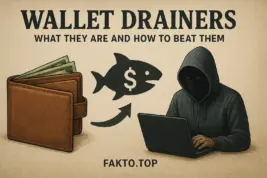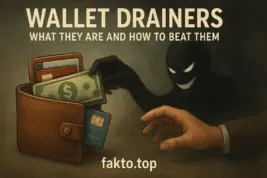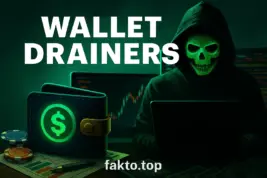Wallet Drainers in Crypto: How to Spot, Block, and Beat Them
Wallet Drainers: What They Are and How to Beat Them
Let’s get one thing straight: wallet drainers aren’t magic, and they’re not unstoppable. They’re smart contracts designed to do one thing — take your assets the moment you give them permission. No seed phrase, no password, no brute force. Just one click, one approval, and it’s over.

But here’s the good news: wallet drainers only work if you let them. That means you can stop them. You can outsmart them. You can build habits that make you immune. This guide breaks it down in plain English — no jargon, no fear tactics, just real talk and real defense.
What Is a Wallet Drainer?
A wallet drainer is a malicious smart contract that tricks you into approving access to your tokens. Once approved, it can transfer your assets out — instantly, silently, and permanently. It doesn’t need your seed phrase. It doesn’t need to “hack” anything. It just needs you to click “Approve.” That’s the trap. And it’s everywhere: fake airdrops, phishing sites, fake staking platforms, scam NFT mints, and even cloned versions of legit dApps.
How Wallet Drainers Actually Work
Here’s the basic flow:
- You connect your wallet to a site that looks legit.
- The site asks you to approve a token or contract.
- You click “Approve” — often without reading the details.
- The contract now has permission to move your assets.
- It drains your wallet — sometimes instantly, sometimes later.
No transaction alert. No confirmation. Just gone. And because it’s on-chain, there’s no undo button. That’s why prevention is everything.
Why People Still Fall for It
Everyone knows wallet drainers exist. But every day, new victims appear. Why? Because the attack doesn’t feel like an attack. It feels like a normal interaction. The site looks clean. The project sounds exciting. The approval feels routine. And that’s the danger — it’s disguised as everyday crypto life. Add a little urgency (“limited mint!”), a little hype (“partnered with X!”), and a little fatigue (“I’ve done this a hundred times”), and boom — you’re vulnerable.
Common Wallet Drainer Scenarios
| Scenario | How It Tricks You | What You Lose |
|---|---|---|
| Fake NFT Mint | Looks like a legit drop, uses urgency | Your ETH or NFTs |
| Phishing Site | Cloned version of a real dApp | Any approved tokens |
| Fake Airdrop | Promises free tokens, asks for approval | Stablecoins, ETH, or wrapped assets |
| Malicious Staking | Offers high APY, hides transfer logic | Staked tokens and more |
| Discord “Support” Scam | Impersonates team, sends fake link | Everything in your hot wallet |
How to Spot a Wallet Drainer

You don’t need to be a dev to spot a drainer. You just need to slow down and look for red flags:
- Unverified Contracts: If the token or dApp isn’t verified on Etherscan, pause.
- Unlimited Approvals: If the approval asks for unlimited access, ask why.
- New Domain: Scam sites often use fresh domains with no history.
- Fake Social Proof: Bot comments, fake likes, cloned influencers.
- Urgency Tactics: Countdown timers, “last chance,” or “only 100 spots.”
If something feels off, it probably is. Trust your instincts — but verify with facts.
How to Protect Yourself
Here’s the part that matters most. These habits will keep you safe — if you actually use them:
- Use a Cold Wallet: Store your long-term assets in a hardware wallet. Never connect it to random sites.
- Separate Wallets: One for DeFi, one for NFTs, one for storage. If one gets drained, the others survive.
- Revoke Approvals Weekly: Use revoke.cash or similar tools to clean up old permissions.
- Bookmark Trusted Sites: Never click links from DMs, tweets, or Discord. Use bookmarks.
- Read Before You Sign: Don’t approve contracts blindly. Check what you’re signing.
- Limit Approvals: Choose “limited” instead of “unlimited” when possible.
These steps aren’t optional. They’re your firewall. And they work — if you stick to them.
Real-World Examples
A user connects to a fake staking site promoted via Twitter. The interface looks identical to a legit protocol. They approve their tokens. Nothing happens — for two days. Then their wallet is drained. No alert, no warning. Just gone.
Another user joins a Telegram group for a new token launch. The chat is active, the team looks real. They buy in. The token has no liquidity. They’re stuck. These aren’t rare stories — they’re daily ones. And they all start with emotion.

An NFT collector clicks a mint link from a Discord “mod.” The site looks perfect. They connect, approve, and mint. But the contract includes a hidden transfer function. Their NFTs are gone before the page reloads.
A DeFi user sees a tweet from a verified-looking account offering “early access” to a new yield platform. The link leads to a cloned site. They approve a token. Hours later, their stablecoins vanish. The tweet is deleted. The account was hacked.
Mindset Matters
Wallet security isn’t just technical — it’s psychological. The biggest risk isn’t the drainer contract. It’s your behavior. Your impulse to click fast. Your habit of trusting visuals. Your fatigue after a long day. That’s what scammers exploit. So build a mindset that defaults to caution. Assume every site is suspicious until proven safe. Assume every approval is dangerous until verified. Assume every “support” message is fake until confirmed. This isn’t paranoia — it’s survival.
Final Recommendations
Wallet drainers are simple — but deadly. They don’t need to break encryption. They just need you to click. That’s why your habits matter more than your tech. Use cold wallets. Separate your assets.

Revoke approvals weekly. Bookmark trusted platforms. Read before you sign. Limit access. And most importantly — slow down. Because in crypto, speed kills. The moment you rush is the moment you get drained. Stay skeptical. Stay structured. Stay safe.
Wallet Safety Is a Habit, Not a Feature
If you remember one thing from this guide, let it be this: wallet drainers don’t break in — they walk through the front door you left open. Every approval matters. Every connection counts. And every shortcut you take is a risk you didn’t need to accept. This isn’t about paranoia — it’s about discipline.
Bookmark trusted sites. Revoke permissions weekly. Separate your wallets. Read before you sign. Limit access. These aren’t suggestions — they’re survival tactics. The crypto space moves fast, but your security should move slow. Pause before you click. Verify before you trust.
And never assume you’re too small to be targeted. Wallet safety isn’t built into your tools — it’s built into your behavior. Make it routine. Make it boring. Make it automatic. Because in crypto, the only thing standing between you and a drainer is you.
